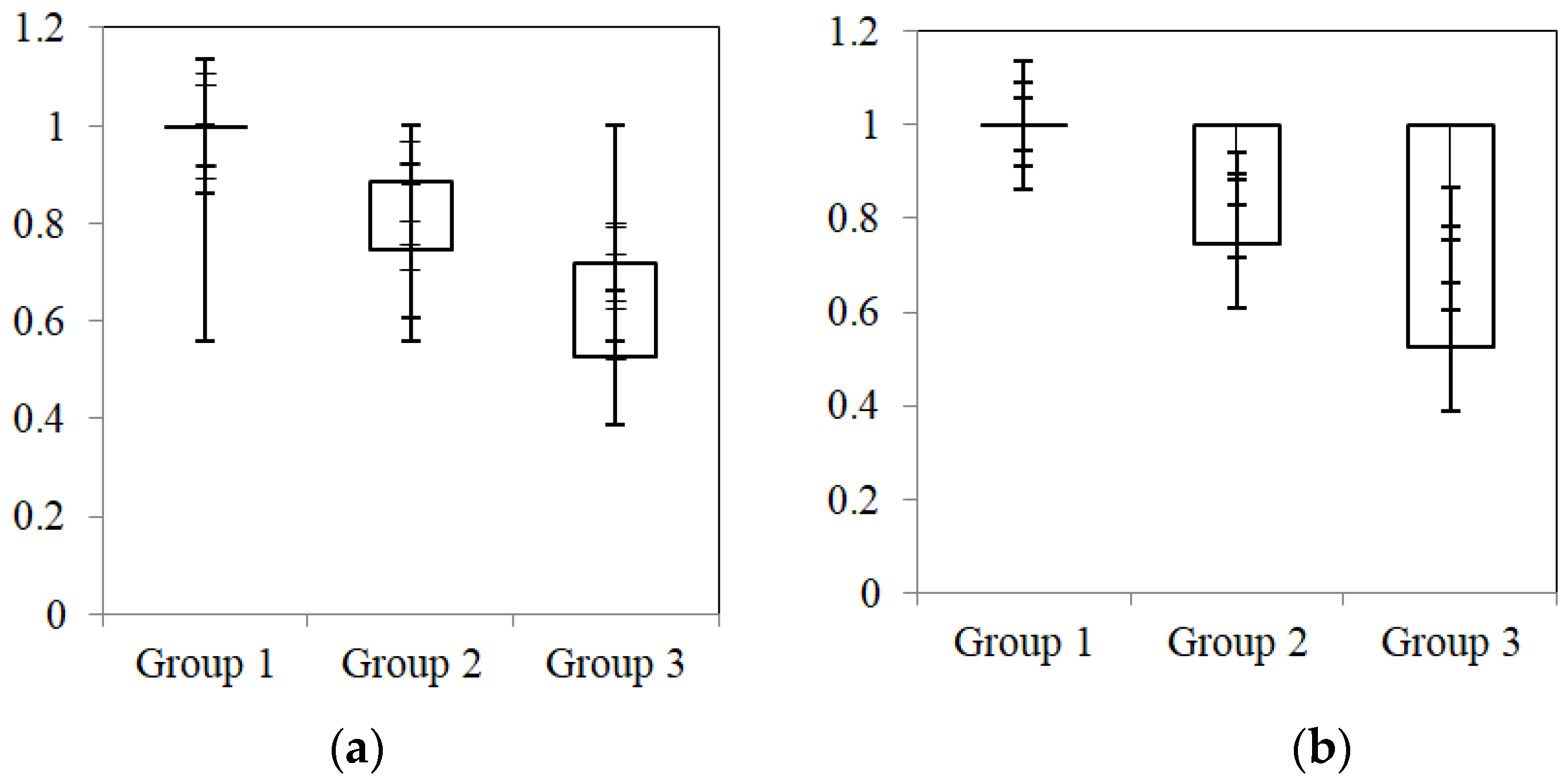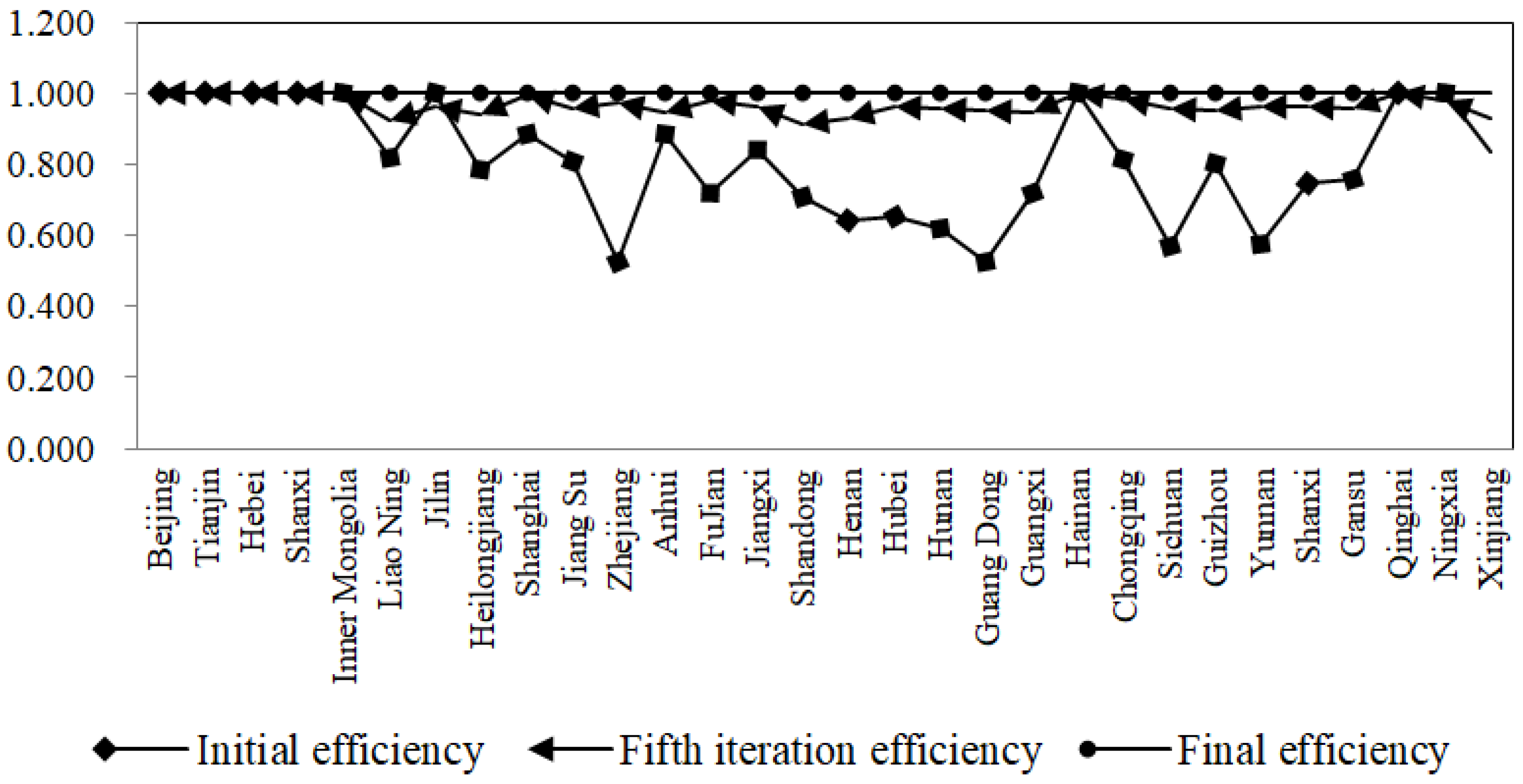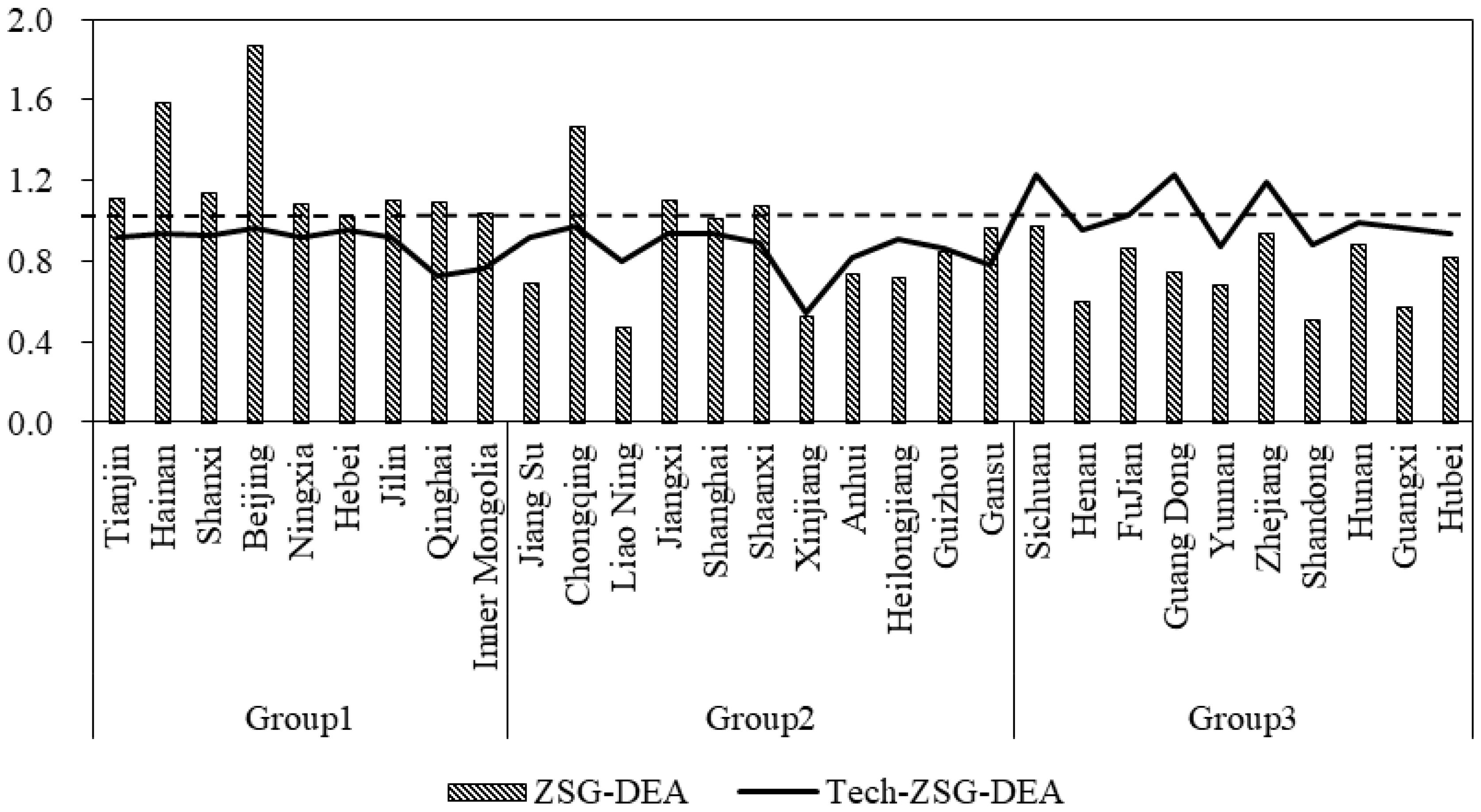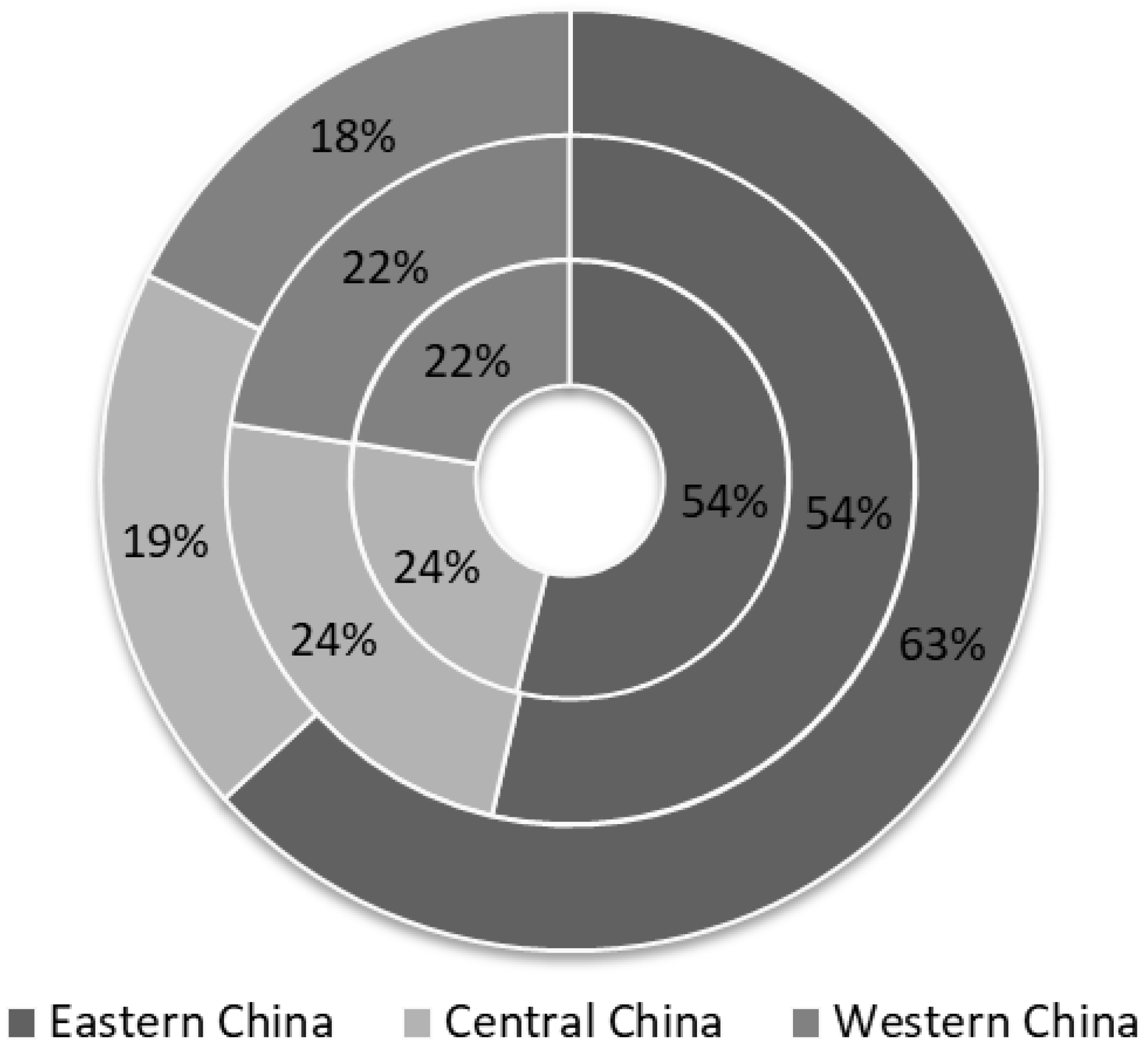Decomposition of China’s Carbon Emissions Responsibility from the Perspective of Technological Heterogeneity
Abstract
1. Introduction
2. Research Methodology and Data
2.1. Research Methodology and Modeling
2.1.1. ZSG-DEA Model Considering Technological Heterogeneity
2.1.2. Explanation of the Principle of Decomposition
2.2. Data Sources and Descriptions
2.2.1. Data Sources and Variable Descriptions
2.2.2. Calculation Formula for Carbon Dioxide Emissions
3. Results
3.1. Projections of Total Carbon Emissions
3.2. Calculation Results of Tech-ZSG-DEA Based on the Principle of Efficiency
3.2.1. Calculation Results of the Initial DEA Based on the Principle of Efficiency
3.2.2. Tech-ZSG-DEA Iterative Process and Reallocation of CO2 Based on the Principle of Efficiency
3.2.3. Comparison of Tech-ZSG-DEA Model and ZSG-DEA Model Decomposition Schemes
3.3. Calculation Results of Tech-ZSG-DEA Based on the Principles of Equity, Output Value, and Retroactivity
3.4. Calculation Results of ZSG-DEA Based on Multiple Principles
4. Discussion
5. Conclusions
Author Contributions
Funding
Institutional Review Board Statement
Informed Consent Statement
Data Availability Statement
Conflicts of Interest
References
- Xi, J. Holding High the Great Banner of Socialism with Chinese Characteristics and Striving in Unity for the Comprehensive Construction of a Modernized Socialist Country—Report at the Twentieth National Congress of the Communist Party of China; People’s Daily Press: Beijing, China, 2022. [Google Scholar]
- Wang, W.; Kong, X. Research on Carbon Allowance Allocation among Chinese Provinces and Municipalities Based on the 2030 Peak Carbon Goal. J. Quant. Tech. Econ. 2022, 39, 113–132. [Google Scholar]
- Li, Y.; Li, Z.; Wu, M.; Zhang, F.; De, G. Regional-Level Allocation of CO2 Emission Permits in China: Evidence from the Boltzmann Distribution Method. Sustainability 2018, 10, 2612. [Google Scholar] [CrossRef]
- Jiang, H.; Shao, X.; Zhang, X.; Bao, J. A Study of the Allocation of Carbon Emission Permits among the Provinces of China Based on Fairness and Efficiency. Sustainability 2017, 9, 2122. [Google Scholar] [CrossRef]
- Sun, M.; Li, C.; Xing, Z.; Yu, Y. Analysis of Key Influencing Factors and Scenario Projections of China’s Carbon Emissions under Carbon Neutral Targets. High Volt. Eng. 2023, 49, 4011–4022. [Google Scholar]
- Tollefson, J. China’s carbon emissions could peak sooner than forecast. Nature 2016, 531, 425–426. [Google Scholar] [CrossRef] [PubMed]
- Zhang, X.; Karplus, V.J.; Qi, T.; Zhang, D.; He, J. Carbon emissions in China: How far can new efforts bend the curve? Energy Econ. 2016, 54, 388–395. [Google Scholar] [CrossRef]
- Zhang, B.; Wang, J.; Yan, Z. Structural Decomposition of Peak Carbon Pathways and Their Drivers in Chinese Cities. China Popul. Resour. Environ. 2023, 33, 38–44. [Google Scholar]
- Sun, J.; Sun, Q.; Gao, J.; Zhang, S.; Qiao, J. Research on the optimization of transport structure under carbon peaking constraints. Ecol. Econ. 2023, 39, 54–59. [Google Scholar]
- Fu, Y.; Ma, S.; Song, Q.; Gao, J. Research on Decomposition of Influential Factors of Carbon Emission in China Based on LMDI. J. Math. Pract. Theory 2019, 49, 7–17. [Google Scholar]
- Du, Q.; Chen, Q.; Lu, N. Projections of China’s future carbon emissions based on an improved IPAT model. Acta Sci. Circumstantiae 2012, 32, 2294–2302. [Google Scholar]
- He, Y.; Yu, J. Research on optimization of China’s carbon emissions and industrial structure based on the STIRPAT model. Environ. Eng. 2018, 36, 174–178+184. [Google Scholar]
- Xu, G.; Wang, Y.; Rehman, H. The future trajectory of carbon emissions in the process of carbon neutrality in South Korea. J. Environ. Manag. 2023, 345, 118588. [Google Scholar] [CrossRef] [PubMed]
- Liu, Z.; Zhang, Y. Characteristics of spatial and temporal jumps in China’s carbon emissions, influencing factors and the design of peak pathways. J. Southwest Univ. (Soc. Sci. Ed.) 2022, 48, 99–112. [Google Scholar]
- Xu, D. Capital Deepening, Technological Progress and the Formation of Carbon Emission EKC in China. Syst. Eng. Theory Pract. 2022, 42, 1632–1643. [Google Scholar]
- Li, G.; Song, F.; Chen, J.; Diao, L.; Wang, Y. Structure-type-capacity optimization model for integrated energy systems considering carbon emissions. Electr. Power Constr. 2022, 43, 37–47. [Google Scholar]
- Su, Y.; Liu, X.; Ji, J.; Ma, X. Role of economic structural change in the peaking of China’s CO2 emissions: An input-output optimization model. Sci. Total Environ. 2021, 761, 143306. [Google Scholar] [CrossRef]
- Du, H.; Zhao, L.; Liu, C.; Qiu, K.; Li, H. Carbon Peak Prediction and Uncertainty Analysis of Main Urban Areas Based on LEAP and KAYA Models. J. Ecol. Rural. Environ. 2022, 38, 983–991. [Google Scholar]
- Wang, Y.; Wang, E.; Bi, Y. The Impact of Peak Carbon Emissions on China’s Economy under Different Scenarios: An Analysis Based on the CGE Model. Resour. Sci. 2017, 39, 1896–1908. [Google Scholar]
- Zheng, L. Apportionment of Carbon Emission Reduction Responsibilities among Chinese Provinces and Regions--A Research Based on Zero-Sum Gain DEA Modelling. Resour. Sci. 2012, 34, 2087–2096. [Google Scholar]
- Yuan, J.; Chen, L.; Hu, M. Spatial and temporal variability of green water use efficiency and its influencing factors in the “Central Four Corners”-based on the non-expected output SBM-DEA and geoprobe models. Ecol. Econ. 2023, 39, 138–147. [Google Scholar]
- Żyłowski, T.; Kozyra, J. Crop Cultivation Efficiency and GHG Emission: SBM-DEA Model with Undesirable Output Approach. Sustainability 2023, 15, 10557. [Google Scholar] [CrossRef]
- Yu, X. An assessment of the green development efficiency of industrial parks in China: Based on non-desired output and non-radial DEA model. Struct. Chang. Econ. Dyn. 2023, 66, 81–88. [Google Scholar] [CrossRef]
- Huang, B.; Wang, Z.; Yan, J.; Gong, L. A two-stage model for allocating carbon credits to the provincial power sector under the “dual-carbon” objective. Stat. Decis. 2023, 39, 168–173. [Google Scholar]
- Zhao, R.; Liu, J.; Long, H.; Xiong, X.; Wu, D. A ZSG-DEA model with factor constraint cone-based decoupling analysis for household CO2 emissions: A case study on Sichuan province. Environ. Sci. Pollut. Res. 2023, 30, 93269–93284. [Google Scholar] [CrossRef] [PubMed]
- Ye, P.; Cai, W.; Zhou, Y. Research on the Initial Allocation of Regional Energy Use Rights and Carbon Emission Rights in China from the Perspective of Technological Heterogeneity. Soft Sci. 2023, 37, 114–121. [Google Scholar]
- Liu, H.; Wang, Y. Research on the Initial Allocation of Energy Use Rights and Carbon Emission Rights Based on the Historical Method and Zero-Sum DEA Approach. Chin. J. Manag. Sci. 2020, 28, 209–220. [Google Scholar]
- Zhao, L.; Leng, M.; Sun, C. Measurement of Integrated Water Resources Pollution Allocation Efficiency in China Based on Multidimensional Output ZSG-DEA Modeling. Water Resour. Prot. 2021, 37, 94–102. [Google Scholar]
- Linghu, D.; Wu, X.; Ye, F. Research on Carbon Allowance Allocation and Trading Mechanism Considering Double Heterogeneity. Chin. J. Manag. Sci. 2021, 29, 176–187. [Google Scholar]
- Zhu, Q.; Chen, X.; Chen, J.; Wu, J. Research on Renewable Energy Power Quota Allocation Mechanism for Regional Power Enterprises in China. Chin. J. Manag. Sci. 2022; online first publish. [Google Scholar]
- Cai, W.; Liu, Q.; Li, R.; Huo, T.; Gao, J. Interprovincial Allocation of Total Building Energy Consumption in the Context of Carbon Emission “Double Control”-Based on the Perspective of Equity and Efficiency Coupling. J. Arid Land Resour. Environ. 2023, 37, 100–109. [Google Scholar]
- Liu, Q.; Gao, J.; Cai, W.; Huo, T.; Li, R. A novel allocation method of regional carbon allowance in the building sector: Perspective from coupling equity and efficiency. Environ. Impact Assess. Rev. 2023, 102, 107192. [Google Scholar] [CrossRef]
- Zhang, Z.; Liu, Y.; Du, Z. CO2 Emission Allocation for Urban Public Buildings Considering Efficiency and Equity: An Application at the Provincial Level in China. Buildings 2023, 13, 1570. [Google Scholar] [CrossRef]
- Cong, J.; Shi, Y.; Gao, H.; Zhao, Y. Research on China’s Provincial and Municipal Carbon Emission Responsibility Accounting under the “Dual Carbon” Goal: Based on the Perspective of “Revenue Responsibility”. J. Shanghai Univ. Financ. Econ. 2021, 23, 82–96. [Google Scholar]
- Wei, R.; Peng, S.; Zhang, W. Carbon Emission Responsibility Sharing in Global Value Chains: Based on a Value Capture Perspective. Int. Econ. Trade Res. 2022, 38, 37–51. [Google Scholar]
- Charnes, A.; Cooper, W.W.; Rhodes, E. Measuring the efficiency of decision-making units. Eur. J. Oper. Res. 1978, 6, 429–444. [Google Scholar] [CrossRef]
- Banker, R.D.; Charnes, A.; Cooper, W.W. Some Models for Estimating Technical and Scale Inefficiencies in Data Envelopment Analysis. Manag. Sci. 1984, 30, 1078–1092. [Google Scholar] [CrossRef]
- Guo, J.; Liu, H.; Wu, X.; Wang, Y. Study on the Efficiency of Air Pollutant Emission Right Allocation Based on ZSG-DEA Modeling. China Soft Sci. 2015, 11, 176–185. [Google Scholar]
- Lins, M.P.; Gomes, E.G.; de Mello, J.C.; de Mello, A.J. Olympic ranking based on a zero sum gains DEA model. Eur. J. Oper. Res. 2003, 148, 312–322. [Google Scholar] [CrossRef]
- Lin, T.; Ning, J. A Study on the Efficiency of Carbon Emission Right Allocation in European Union Countries Based on Zero-Sum DEA Modeling. J. Quant. Tech. Econ. 2011, 3, 36–50. [Google Scholar]
- Miao, Z.; Zhou, P.; Li, X. Research on the efficiency allocation of provincial energy intensity constraints in the Eleventh Five-Year Plan. China Popul. Resour. Environ. 2013, 23, 58–64. [Google Scholar]
- Wang, Q.; Li, J. Study on the Efficiency of Carbon Emission Right Allocation in China’s Pilot Provinces and Municipalities under Weak Correlation Constraints. Soft Sci. 2016, 3, 81–107. [Google Scholar]
- Miao, Z.; Zhou, P.; Li, X. Research on China’s Carbon Emission Allowance Allocation Based on European Union’s Allocation Principle-Based on ZSG Environmental Production Technology. Econ. Perspect. 2013, 4, 89–98. [Google Scholar]










| Category | Indicator Name | Interpretation of Indicators | Unit (of Measure) |
|---|---|---|---|
| Input indicators | Population | Number of residents by province | Ten thousand people |
| Energy consumption | Energy intensity by province | Ten thousand tons of standard coal | |
| Water consumption | Water intensity by province | Cubic meters | |
| Capital stock | Total capital resources available in the provinces | Billion | |
| Output indicators | Economic level | GDP per capita by province | CNY |
| CO2 | Carbon dioxide emissions by province | Ten thousand tons |
| Variable | Value | Variable | Value |
|---|---|---|---|
| Mult R | 0.9961 | SE | 0.0415 |
| R-square | 0.9923 | F value | 128.0393 |
| Adj R-square | 0.9845 | Significance F | 0.0000 |
| Independent Variable | B | SE (B) | Beta | B/SE (B) |
|---|---|---|---|---|
| lnP | 1.7718 | 0.2013 | 0.1720 | 8.8006 |
| lnU | 0.4922 | 0.0383 | 0.2434 | 12.8407 |
| lnA | 0.1362 | 0.0094 | 0.2836 | 14.4207 |
| lnT | −0.2122 | 0.0422 | −0.2296 | −5.0320 |
| lnY | 1.1250 | 0.2028 | 0.2666 | 5.5467 |
| lnI | −0.0822 | 0.0266 | −0.1017 | −3.0916 |
| lnF | 0.5599 | 0.1817 | 0.1558 | 3.0819 |
| lnW | −0.1221 | 0.0095 | −0.2582 | −12.8398 |
| lnR | 0.1657 | 0.0681 | 0.08587 | 2.4339 |
| lnS | −0.0303 | 0.0301 | −0.0397 | −1.0068 |
| Constant | −11.5576 | 2.4870 | 0.0000 | −4.6473 |
| Regions | Initial Efficiency | Initial Carbon Emissions (Ten Thousand Tons) | Efficiency after Iterations | Carbon Allocation after Iteration (Ten Thousand Tons) |
|---|---|---|---|---|
| Beijing | 1.000 | 13,706.970 | 1.000 | 80,544.581 |
| Tianjin | 0.252 | 20,766.969 | 0.999 | 49,610.387 |
| Hebei | 0.021 | 94,389.950 | 0.995 | 23,702.936 |
| Shanxi | 0.037 | 56,892.788 | 0.996 | 24,693.394 |
| Inner Mongolia | 0.039 | 78,622.842 | 0.997 | 35,257.568 |
| Liaoning | 0.045 | 55,311.337 | 0.997 | 28,801.710 |
| Jilin | 0.103 | 22,475.296 | 0.998 | 24,978.833 |
| Heilongjiang | 0.068 | 27,760.411 | 0.998 | 21,007.263 |
| Shanghai | 0.372 | 23,684.063 | 1.000 | 76,003.212 |
| Jiangsu | 0.068 | 77,767.886 | 0.998 | 59,200.879 |
| Zhejiang | 0.124 | 37,120.792 | 0.999 | 48,878.071 |
| Anhui | 0.070 | 39,522.892 | 0.998 | 30,958.308 |
| Fujian | 0.175 | 29,195.801 | 0.999 | 51,622.824 |
| Jiangxi | 0.103 | 24,857.506 | 0.999 | 27,769.452 |
| Shandong | 0.035 | 85,011.731 | 0.997 | 35,181.457 |
| Henan | 0.053 | 44,819.107 | 0.997 | 27,034.071 |
| Hubei | 0.106 | 32,232.651 | 0.999 | 36,741.725 |
| Hunan | 0.092 | 30,389.486 | 0.998 | 30,713.485 |
| Guangdong | 0.071 | 53,809.526 | 0.998 | 42,931.889 |
| Guangxi | 0.074 | 26,248.808 | 0.998 | 21,589.473 |
| Hainan | 1.000 | 6889.325 | 1.000 | 40,482.728 |
| Chongqing | 0.232 | 17,050.042 | 0.999 | 38,098.659 |
| Sichuan | 0.091 | 28,350.210 | 0.998 | 28,368.531 |
| Guizhou | 0.079 | 25,828.604 | 0.998 | 22,579.479 |
| Yunnan | 0.104 | 22,640.628 | 0.999 | 25,370.750 |
| Shaanxi | 0.101 | 29,538.386 | 0.999 | 32,351.275 |
| Gansu | 0.089 | 17,953.014 | 0.998 | 17,602.353 |
| Qinghai | 1.000 | 8889.925 | 1.000 | 52,236.999 |
| Ningxia | 0.166 | 24,800.512 | 0.999 | 41,970.337 |
| Xinjiang | 0.050 | 45,823.391 | 0.997 | 26,068.219 |
Disclaimer/Publisher’s Note: The statements, opinions and data contained in all publications are solely those of the individual author(s) and contributor(s) and not of MDPI and/or the editor(s). MDPI and/or the editor(s) disclaim responsibility for any injury to people or property resulting from any ideas, methods, instructions or products referred to in the content. |
© 2024 by the authors. Licensee MDPI, Basel, Switzerland. This article is an open access article distributed under the terms and conditions of the Creative Commons Attribution (CC BY) license (https://creativecommons.org/licenses/by/4.0/).
Share and Cite
Song, Q.; Xie, Y.; Yang, C. Decomposition of China’s Carbon Emissions Responsibility from the Perspective of Technological Heterogeneity. Sustainability 2024, 16, 3978. https://doi.org/10.3390/su16103978
Song Q, Xie Y, Yang C. Decomposition of China’s Carbon Emissions Responsibility from the Perspective of Technological Heterogeneity. Sustainability. 2024; 16(10):3978. https://doi.org/10.3390/su16103978
Chicago/Turabian StyleSong, Qing, Yi Xie, and Chuanming Yang. 2024. "Decomposition of China’s Carbon Emissions Responsibility from the Perspective of Technological Heterogeneity" Sustainability 16, no. 10: 3978. https://doi.org/10.3390/su16103978
APA StyleSong, Q., Xie, Y., & Yang, C. (2024). Decomposition of China’s Carbon Emissions Responsibility from the Perspective of Technological Heterogeneity. Sustainability, 16(10), 3978. https://doi.org/10.3390/su16103978







